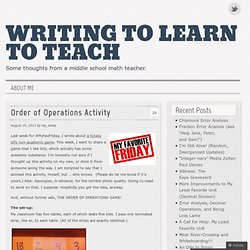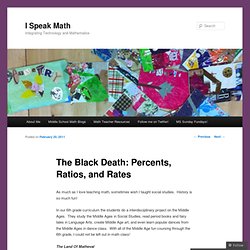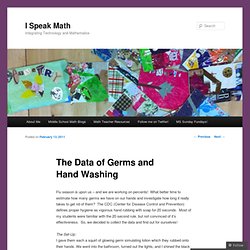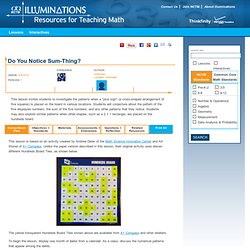

Untitled Document. Home > Grades 3-4 > Math > Multiplication > Home Site Map Comments Parents Teachers Privacy Policy and Terms of Use K-2 ( Math, Language Arts) 3-4 ( Math, Language Arts) 5-8 ( Math, Language Arts) All Ages (MindTwisters, Games) Advertise info@dositey.com.

Order of Operations Activity « Writing to Learn to Teach. Last week for #MyFavFriday, I wrote about a totally silly non-academic game.

This week, I want to share a game that I like lots, which actually has some academic substance. I’m honestly not sure if I thought up this activity on my own, or stole it from someone along the way. I am tempted to say that I devised this activity, myself, but … who knows. (Please do let me know if it’s yours.) Also: Apologies, in advance, for the terrible photo quality. And, without further ado, THE ORDER OF OPERATIONS GAME! The set-up:My classroom has five tables, each of which seats five kids. Each table also gets an envelope with the following pieces: [Update, 8/27/12: The one and only @jreulbach created a characteristically well-designed version of the game pieces that you see above. How it works:You start the game by calling out a number. So, let’s say you shout out, “77!” Kids immediately start scurrying and scratchworking and talking and debating. I weave around the room and eavesdrop. Suddenly– P.S.
The Black Death: Percents, Ratios, and Rates. As much as I love teaching math, sometimes wish I taught social studies.

History is so much fun! In our 6th grade curriculum the students do a interdisciplinary project on the Middle Ages. They study the Middle Ages in Social Studies, read period books and fairy tales in Language Arts, create Middle Age art, and even learn popular dances from the Middle Ages in dance class. With all of the Middle Age fun coursing through the 6th grade, I could not be left out in math class! The Data of Germs and Hand Washing. Flu season is upon us – and we are working on percents!

What better time to estimate how many germs we have on our hands and investigate how long it really takes to get rid of them? The CDC (Center for Disease Control and Prevention) defines proper hygiene as vigorous hand rubbing with soap for 20 seconds. Most of my students were familiar with the 20 second rule, but not convinced of it’s effectiveness. PEMDAS SONG (with lesson) order of operations! Mr. Duey - Fractions. MNM: Angle Foldables.
Well hello there!!! I have been on a blog frenzy.... hopefully I can keep it going! Only 6 more weeks of school---I can NOT believe how this year had just flown by!!! I am hoping that I can do a lot of posts this summer about notebooking.... but as for today... we are making foldables on...... You can use these foldables with anything you are teaching not just math. Over the course of the year I save a ton of paper scraps. 5thGradeCCFractionActionFREE.pdf. Do You Notice Sum-Thing? This lesson is based on an activity created by Andrew Derer of the Math Science Innovation Center and Art Stoner of A+ Compass.

Unlike the paper version described in this lesson, their original activity uses eleven different Hundreds Board Tiles, as shown below. The yellow transparent Hundreds Board Tiles shown above are available from A+ Compass and other retailers. To begin the lesson, display one month of dates from a calendar. As a class, discuss the numerical patterns that appear among the dates.
To facilitate this discussion, choose a date in the middle of the month, and ask the following questions: What number is in the square above this one? Explain to students that they will now investigate patterns on a hundreds board. This activity sheet contains a hundreds board at the top and a template to create a "plus sign" at the bottom. In the image above, the plus sign reveals five numbers, 23, 32, 33, 34, and 43. Math Vocabulary Bingo. Before using the Math Bingo game with your students, you may want to examine the Math Bingo Clue Cards for applicability to your classroom.

The vocabulary emphasized on these cards is taken from a 4th‑grade textbook and based on the mathematics standards for grades 3‑5. Depending on your curriculum, you may wish to replace some of the cards with clues that are more appropriate. (You will need to create alternate clues.) In addition, you will also need Bingo cards for the students.
There are lots of free online options, or you can use the Bingo Card Spreadsheet to produce a set of your own. Begin this lesson by telling the students that they are going to play Bingo. After ensuring that all students understand the game format and rules, tell the students that the game they will play today is called Math Bingo. Begin the game by reading clues aloud to students. The game proceeds as you continue to call out clues and the students listen. Questions for Students.